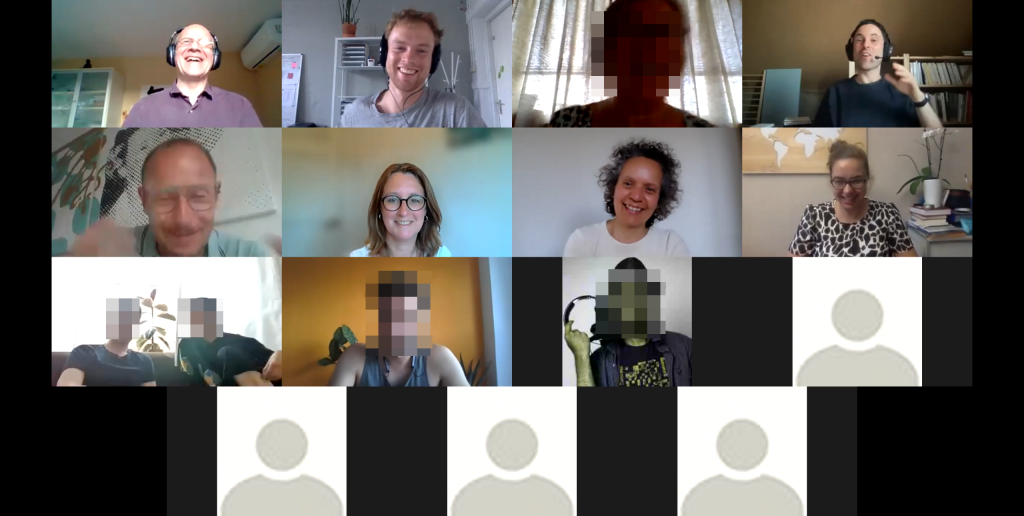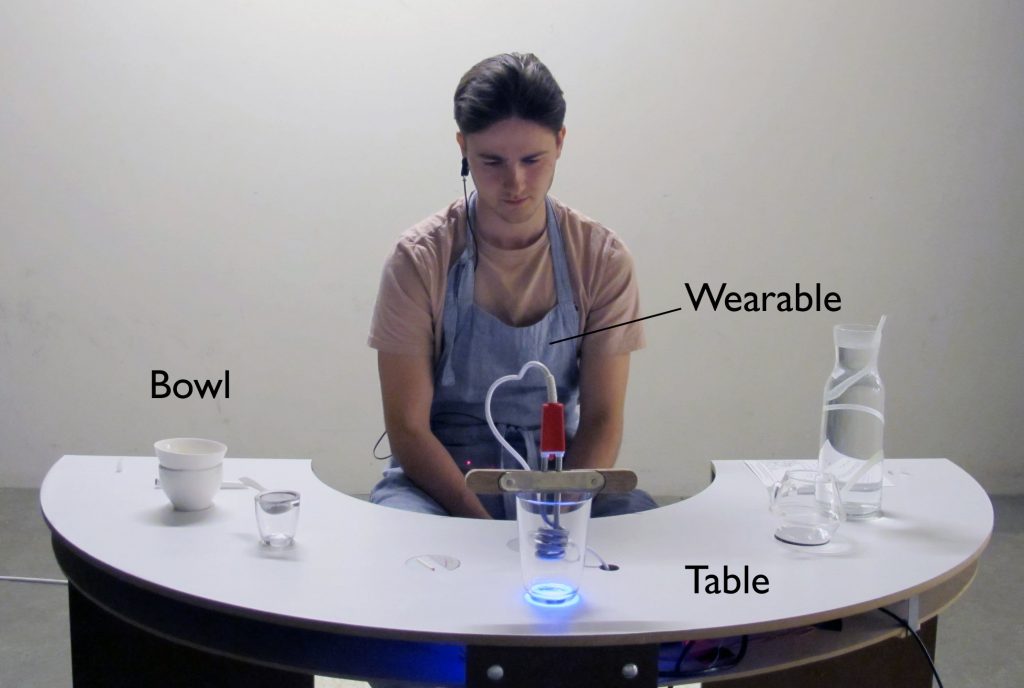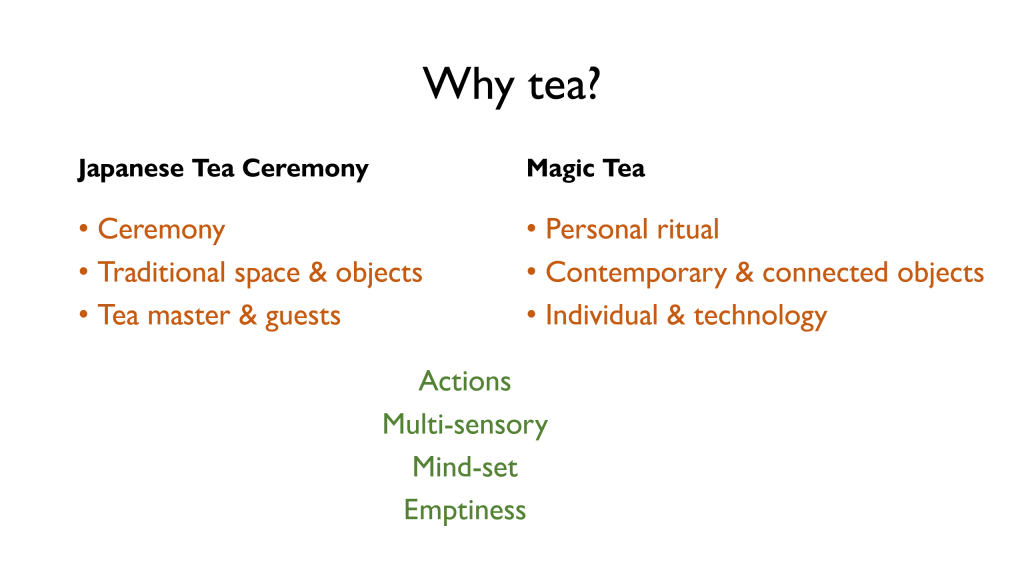This event on June 14th finalized the residency period of Danielle Roberts at Baltan Laboratories. During the residency Danielle improved and tested the research prototype Magic Tea, an interactive art installation aimed at inviting self-transcendent experiences (STEs) during the act of preparing and drinking tea.
The aim of this meetup was to introduce the thinking behind the Magic Tea design to a broader public and to discuss with a group of experts the possibilities and pitfalls of using technology to invite STEs.

Introduction
The event started with a presentation by Danielle. It was an in depth explanation of her approach on merging the ordinary and the extraordinary through the use of technology. Danielle explained how she came to choose tea as an everyday activity. She elaborated on the role of rituals as a way to make the everyday more meaningful and how the combination of ritualisation and tangible Internet of Things technology may invite an STE and lead to a feeling of reduced self and increased connectedness in the user. The different steps of the Magic Tea ritual were illustrated as well as the promising results of the first prototype. The Everyday Transformative Interfaces Framework is introduced as a tool to help designers create STE inviting interventions.

After the presentation Rens van der Vorst moderated the questions of the audience and invited the panel members to reflect from their own perspective on what they had heard and/or experienced about Magic Tea.
Panel member perspectives
Somaya Ben Allouch researches the interaction between ubiquitous computing, human-computer interaction and health. In my culture tea (green tea with lots of sugar) is used in various ceremonies e.g. weddings, funerals. There are strict rules on tea recipes for these events they have a huge impact on how people experience them. Magic Tea was interesting because of the devised steps and the role of technology, the interaction design. Some parts were intuitive and others weren’t so much. The order in which to start the boiling process for example seemed illogical and I started thinking about that which took me out of the relaxation mode. The meaning of the vibration in the cup is ambiguous. This took me out of the experience but also increased my awareness and made me reflect. But do we need technology to enhance rituals and who would benefit from that?
Michel Decré is a traditionally trained tea master and technologist and is very interested in how technology may enhance these practices, even the most traditional ones. Because in the 16th century Sen no Rikyū introduced Zen into the tea ceremony and revolutionised is. Challenging traditions is important to keep them alive. Magic Tea succeeded well invoking a flow and it has potential to really work. But once you start thinking about the technology the flow is interrupted and it should support the flow to fully work.
Janienke Sturm works at the intersection of psychology and technology and one of her research topics is human centred design. Janienke sees a similarity with Magic Tea and her own coffee ritual which she has handed over to a modern machine which only requires you to put in a pad. She misses the richness of the experience and stresses the importance of rituals to create meaning and order. She encourages any attempt to introduce rituals. The HCI field traditionally was focussed very much on functionality and efficiency and has moved on to a more experience based approach. Magic Tea is taking this a step further.
Pierre Lévy researches how to enchant the everyday by design which is informed by Japanese philosophy. Routines focus on the result while in a ritual the whole process is important. Japanese philosophy introduces the concept of irregularity (imperfection). Irregularity make us question things and make us wonder about our lives. If things are seamless and perfect one doesn’t question what is going on irregularity however, can start a transformation process. This is a first person experience as an onlooker you will perceive it differently.

The discussion
Michel: the Japanese tea ceremony framework states that every ritual has to have at least one imperfection, by design. Within the rules every ritual is breaking at least one of those rules. Even the most formal one needs imperfection to be perfect.
Pierre responds to a question from Sietske (in the audience) about how different perspectives could influence the way Magic Tea works for users: behavioural economics research shows that the first person perspective is unique, one can gain insights you can’t get any other way. Observing during a tea ceremony is still part of the ceremony and therefore first person engagement. Second level perspective requires a form of communication. Magic Tea is a small, personal ritual, not a social one. How can even more people enjoy it? (third person perspective). How is what you created received by others? You never get what you want because people appropriate. It will be a different experience for everybody but as long as it is in some way enjoyable you have succeeded. Sietske: The experience can be considered a gift. Pierre: The maker is embedded in the installation and can therefore be thanked for the experience.
Janienke: who is the owner of the traditional tea ceremony? Is it the tea master, the visitors or both? Michel: In Zen they say: no host, no guest. Which is about non-duality and unity which is the main goal of STEs. Janienke: Does the introduction of technology instead of a tea master change that? Does it increase the gap between the first and second person perspective? Michel: there is growing evidence that current technologies (e.g. gaming) have a similar effect on the brain as certain brain altering chemicals. We just have to get used to the new role technology can play. With more knowledge of their effects they can be conducive to these types of mental states.
Somaya: the current technology used in Magic Tea is very transparent for the user. What if there was an algorithm to create the perfect tea experience (with irregularities) using large datasets and AI? Could this type of technology improve the chances of experiencing an STE? Danielle: would Magic Tea be perfect if everybody always had an STE while using it? STEs can only be invited and the unexpected is part of that experience. Pierre: if we only look at the results of a ritual that it becomes a routine again. The process should remain interesting for the user in order to have the benefits of the ritual. Looking at an activity through the lens of the result or the experience are two completely different things. If were are interested in the latter it is dangerous to make everything opaque and ungraspable.
Rens: Danielle, you are interested in supporting ordinary people reach their exceptional potential. How do you envision this? Is there a way to stop the de-ritualisation in our lives? Danielle: I could tour around with Magic Tea (like the Spacebuzz project ) and I train designers to help turn our environments into Transformative Interfaces which could be experienced throughout our day. Janienke suggests a pocket size Magic Tea experience. She sees opportunities for a number other returning everyday activities all of which could be turned into potential STEs with a suit of devices. Pierre: routines are important for our mental health and structuring our lives. They give you time for daydreaming. If we question all the aspects of everyday activities we open up opportunities for ritualising routines. But we don’t want everything to be a ritual because it would be to effortful.
Closing remarks
Michel: after a lot of training and repetition it is the unrepeated that triggers the transformative. Can we create a space for that?
Janienke: I gained insight into how to invite transformative experiences into my life: by looking at what can be done differently so they can be invited. But do we need digital technology to do that?
Somaya: tech can make us look differently at everyday activities and it can serve in a reciprocal relationship between you and the world and challenge existing relationships. The Everyday Transformative Interfaces Framework is a useful tool to explore this further.
Panel Members
Prof. Somaya Ben Allouch – Leading expert on the interface of ubiquitous computing, human-computer interaction and health.
Dr. Michel Decré – Decré is an official tea master for Japanese tea ceremonies with a background as physics engineer.
Dr. Pierre Lévy – Lévy is interested in applications of philosophy on interaction design, especially of applying embodiment theories and Japanese philosophy and culture to the everyday.
Dr. Janienke Sturm – Sturm is a language and speech technologist with an expertise in the field of user-oriented design, playful interactions and influencing technology.
Rens van der Vorst – Van der Vorst runs the platform technofilosofie.com and researches ways to make people think about their relationship with technology.
Supported by Baltan Laboratories and Avans University of Applied Sciences, Centre of Applied Research for Art